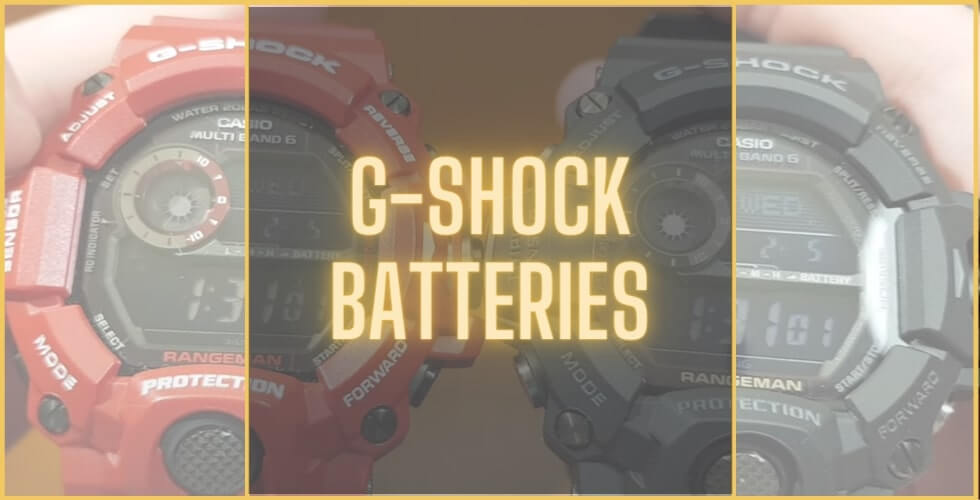The G-Shock series by Casio is not only one of the most recognizable watch lines in the world but also one of the most enduring. All G-Shock models come with an extremely rugged exterior but they are just as durable on the inside, particularly when it comes to their batteries.
The general assumption in the watchmaking industry is that G-Shock timepieces are at the top of the hierarchy when it comes to battery lifespan. So, let’s try and be a bit more precise now: how long do G-Shock batteries last exactly?
Without further ado, off we go.
Disclaimer: As an affiliate, Timepieceking might earn a commission (at no additional cost for you) for purchases made via links in the article.
G-Shock Battery Life: General Rules
Because there are literally hundreds of different G-Shock models on the market, it’s impossible to give a one-for-all answer on the subject. Nevertheless, we can say that the battery in any G-Shock model will easily last for at least 3 years and in some cases, can provide hassle-free use even for as long as two decades.
You might wonder: what contributes to such a massive gap in life expectancy? In short, the two biggest factors are the type of G-Shock watch you own (either a regular one or a solar-powered one) and how much you exploit all the features the watch comes from.
In total, there are 21 different battery types used in Casio G-Shocks. They differ slightly in terms of their weight, replacement price and the average lifespan but the contrast between most is so small it’s not worth going into details for. Nevertheless, we can group G-Shock batteries into two main types: those that are rechargeable and those that are not.
Battery Life In Standard G-Shocks vs G-Shocks Solar
The difference in the battery life between a standard G-Shock watch (with a non-rechargeable battery) and a Tough Solar model is quite huge. By no means should it indicate that the former will die off quickly, though!
So, when it comes to standard models, how long do G-Shock watches last? Even those at the bottom end of the pricing table should serve you for a minimum of 30-36 months. Such a healthy lifespan includes frequent use of most of the popular G-Shock features such as alarms, backlights and more. With a more prudent approach, with some models, you can extend it even up to 10 years!
And how long do G-Shock Solar batteries last? Between 8-10 years, even with all the fancy features on, is a minimum. If you don’t plan to use each of tens of the additional features they come with every day, you can easily prolong that to up to 20 years.
The secret behind such a long lifespan is the fact that the batteries in these watches are rechargeable. All the Casio models using the Tough Solar technology are recharged every time they are exposed to sunlight. The power from the sun is absorbed through a solar panel that subsequently converts it into electrical energy that fuels the battery.
More often than not, G-Shock Solar watches are considerably more expensive than those using the standard battery type. On the other hand, they hold some advantages over regular wristwatches. For one, they are really ecological. Also, any G-Shock Tough Solar will require little-to-zero maintenance and that includes not worrying about any battery changes.
Factors Affecting G-Shock Battery Life
Apart from the type of battery the watch comes with (standard non-rechargeable or solar rechargeable), the next biggest factor contributing to longevity is how you use and exploit your watch on a daily basis.
One thing we all love G-Shocks for is the endless list of additional perks they come from. At the same time, we have to remember that the more of these we frequently use, the sooner the battery will come to a halt.
Leaving the backlight constantly on is a great example of how you can unnecessarily speed up the process of your G-Shock battery dying out quicker. Some people love their G-Shock to glow any time of the day but the best and most pragmatic way to use this feature is to turn it on only when needed – and that is when we want to check the time in an environment deprived of light.
Other popular G-Shock features that can influence the lifespan of your battery include those that are characteristic of hiking watches (altimeter, barometer, compass), alarms, stopwatches and LED displays. Again, use them only when necessary.
Whereas all of the aforementioned functions have been proven to affect battery longevity, one feature that is probably the most battery-draining is the chronograph. If constantly running, the functions of chronographs can shorten the lifespan even by 45%.
Also, exposing your G-Shock to water and other fluids can affect the overall battery condition – but only if you don’t follow the use guidelines that might differ between models.
Last but not least, the temperature in which you store/wear your G-Shock can also contribute to battery life. Unless the model you own is low or high-temperature-resistant, you shouldn’t expose it to extreme conditions and should avoid sudden temperature shifts when possible.
Signs That Your G-Shock Battery Is Not Doing Well
Before your G-Shock comes to a complete stop, it is likely to display some signs of battery “fatigue” first. Let’s have a quick glance at each of those below.
Second-Hand Jumps In Intervals
Unusual behavior of the second hand in any analog Casio G-Shock model is the first sign your battery might need replacing. Not all models do this but, more often than not, a visible change in the work of the second hand is a clear indicator that your G-Shock battery is running on low fuel.
If you spot the second-hand jumping in 4 or 5-second intervals, prepare for the fact that your battery will have to be replaced soon.
G-Shock Features Don’t (Always) Work
Most G-Shock models come with a plethora of additional features. If one of these or all of them doesn’t work at all times or don’t work at all, more often than not it will mean the G-Shock battery is struggling to get by.
Showing the correct time is the most important and basic function of any watch. That’s why the first features that any timepiece is likely to neglect are those that are considered “additional”. Here all the alarms, stopwatches, chronographs and calendars spring to mind. If you notice that one of these is not working as it should, it’s an obvious red flag.
G-Shock Isn’t Showing Correct Time
The most obvious sign of them all.
All Casio watches use the Japanese quartz movement that’s known for its outstanding accuracy. Unlike timepieces that use other types of watch movements (ie. automatic or self-wound) and naturally can lose a couple of minutes per day, the precision of quartz is nearly perfect. If the watch is visibly lagging in that aspect, it’s a clear indicator a new battery is needed.
Prolonging Your G-Shock Battery Life
Prudent yet pragmatic use of your Casio G-Shock can help you extend the battery life noticeably.
The best way to squeeze out as long as possible from your G-Shock model is to:
- keep the backlight feature turned off and only use it when essential
- if your model is a chronograph watch, make sure the feature isn’t running 24/7
- make sure the stopwatch is turned off and use when necessary
- follow the water-resistance guidelines specific to your model
- follow the high/low-temperature guidelines specific to your model
Also, for whatever reason, in the last few years, there’s been an odd belief circulating around the quartz watch community that pulling out the stem of your watch completely shuts down the battery work and thus extends its life.
Whereas it’s true that in such a case the battery needs less energy to run, it’s never completely off unless you take it out of the watch altogether. Furthermore, pulling out the stem and leaving the watch inactive for a longer period of time increases the risk of a battery leak and subsequent damage to the movement. Please – let’s celebrate the fact that G-Shocks are amazing quartz watches that have been designed to be “pick up & go” and just let them run!


Having a few of them over time the issue that I find is that the ones that are not solar once you replace batteries 3 or 4 times the bolts that goes in bezel cant tight because where they sit are just the wholes of the polymers that they use instead of adding metal to secure the bolts tight to avoid water getting in the watches.
Gshock gained 4 mins why? Model 5081-100 ga
G-Shocks rated at 30m WR? All G-Shocks are rated at 200m WR.